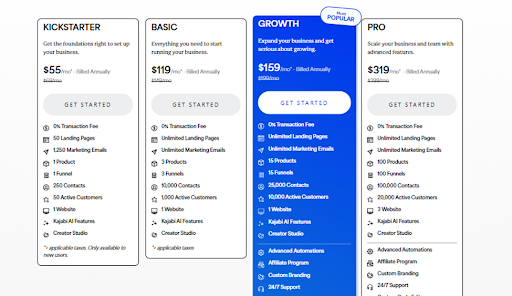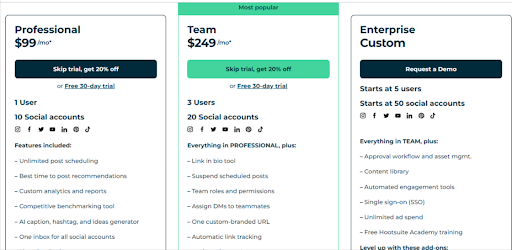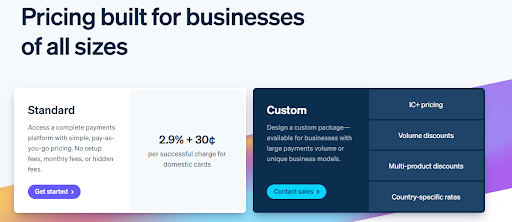From education to entertainment, the membership trend is ringing everywhere!
Membership websites are great for building authority in your niche and earning a recurring income. 70% of business leaders believe memberships and subscription models are the future of business growth.
While businesses are exploring new ways on how to create a membership site, consumers are easily adapting to the growing fad! So, if you have an existing business, membership sites are great to create buzz with a thriving community.
In this article, we break down the basics to build a membership website.
Here’s what you’ll learn:
- What exactly is a membership site & its different types
- The unique benefits of building a membership website
- How to create a membership site
- Successful membership site examples to catch on
Are you ready to play your part in the “membership renaissance”?
Table of Contents
- 1 What is a Membership Site?
- 2 What are the Types of Membership Sites?
- 3 What are the Benefits of Building a Membership Website?
- 4 How to Create a Membership Website in 9 Easy Steps
- 5 Successful Membership Site Examples to Get Inspired
- 6 Emerging Trends for Membership Sites
- 7 Ready to Build a Thriving Community?
- 8 FAQ-Related to How to Create a Membership Site
What is a Membership Site?
A membership website offers exclusive access to gated content and a community for a fixed price. Of course, there are websites offering free membership as well, but the gated aspect is the core of this model!
Businesses can offer any of the following as premium content:
- Online courses
- Coaching programs
- Digital downloads or physical products
- Products
- Podcasts
- Online events
- Videos
- Blogs or articles
- Newsletters & whitepapers
The list is endless….
Users typically log in with their credentials to access the members-only content. Members receive a notification each time new content is uploaded to the website.
Every membership site is tailored around the experience — educate, entertain, experience!
Although both memberships and subscriptions seem similar, there is a thin line that separates them. Membership websites emphasize the power of community-building, while subscription sites focus on offering access to a product or service.
Now, let’s explore the different types of membership websites!
What are the Types of Membership Sites?
Your membership model also plays an important role in the success of your membership website. Choosing the right model that fits your business needs and helps build trust is essential!
Let’s look at the different membership models reigning in the market!
1. Drip Feed Model
In a drip-feed model, content is ” drip-fed” or released at regular intervals. So, members can expect high-quality content on a predefined schedule for a one-off or recurring fee.
2. All-in-One Membership Site
With this model, the members can access all the content immediately without any waiting period. The fee is paid upfront or as a recurring monthly payment.
3. Fixed Membership Model
Here, membership is available for a fixed period of time, after which access expires. Members must renew to extend their membership.
4. Product Membership Model
Members can access an actual product through the subscription period. You might be emailed the login and can use the credentials to access the product. So, each month, a new product is offered through the membership.
5. Service Model
This model offers access to an exclusive online or offline service for a fixed cost. The service could be selling a fitness program or coaching service.
6. Online Course Model
Selling online courses through memberships is an attractive way to offer a steady source of income. Members can access the full content library and specific lessons or gain lifetime access.
7. Freemium Model
In the freemium model, the basic features are available for a free trial or free of cost, while the premium features require a membership.
8. Online Community Site
Community-based membership sites built with online live events, discussion forums, polls, surveys, and content libraries are great ways to engage audiences.
9. Combination Model
Lastly, a hybrid model combining two or more membership models can be an effective approach. For example, you could offer coaching sessions and sell access to a gated community.
What are the Benefits of Building a Membership Website?
Membership websites are one of the profitable ways to start an online business.
Here are some interesting statistics that prove the power of subscriptions:

Let’s explore why you should make a membership website!
-
Earn a Recurring Income
Memberships offer a predictable, consistent and increased income – dousing every creator’s nightmare! This saves on time and money spent on intermittent marketing!
-
Build an Exclusive Community
A membership website offers a platform to exchange new ideas, strike conversations, and build a fantastic community experience! They can interact through forums, direct messages, and activity walls.
-
Become a Brand Expert or Build Authority
Although “content is king” seems cliche, it still holds true! A membership website helps you share valuable content such as blogs, podcasts, newsletters, etc. This insightful content addresses the industry gap and helps you establish yourself as a domain expert!
-
Increase Your Website Traffic
Engaging an exclusive community with gated content certainly helps you grow your subscriber base.
-
Build Customer Trust and Loyalty
Offering high-quality, helpful, and accurate content to members consistently builds a strong relationship with the audience. Winning the trust of your audience helps you build a loyal following.
How to Create a Membership Website in 9 Easy Steps
Now, you know the basics of membership websites and the advantages of a membership website!
Let’s discuss the steps to create a membership site!
1. Choose a Profitable Niche
The beauty of your business is centered around tapping into the right niche. Your niche could make or break your business, and this holds true for membership sites as well!
All the great companies, like Airbnb, Apple, and Amazon, evolved from a single amazing idea addressing an existential niche problem!
If you are creating a membership site to scale your existing business, well you already have a niche!
But, if you are starting out from scratch, ask these questions to discover a suitable niche:
- Do you have expertise or deep knowledge in a specific area?
- What are your hobbies, passions and interests?
- Have you stumbled across an existing gap and the possibility of establishing a business?
- Is there a potential trend or profitable niche idea?
If you’re stuck in the maze, leverage Chris Ducker’s 3-step simple philosophy to cut through the noise!
Step 1: Identify the trending niche market keywords that people frequently search.
Step 2: Analyze the competitiveness of the keyword.
Step 3: Seal the deal with a “Go” or a “No.”
Here are a few fantastic ideas to master the membership game:
- Diet & Fitness
- Stock & Template sites like Shutterstock
- Groups & Communities
- Coaching membership sites
- Fan Membership sites like Patreon
- Entertainment and News
- Digital Art and Design
Tip: It’s recommended to dig deeper, pick a super-specific niche, and validate your niche before starting out.
2. Perform Market Research
Once you have determined your niche, it’s time to research your competitors.
Identify 3-4 competitors in your niche. Create a worksheet listing key competitors and their unique services, membership model, quality content and pricing. Also, evaluate your competitor’s areas of improvement; these are opportunities for business growth.
Leverage tools like Semrush and Google Keywords Planner to explore the competitors vying for your niche market. Look for words with high search volume and low competition to rank quickly on the SERPs.
Stay updated with the prevalent trends and in-demand topics disrupting the market!
3. Pick a Membership Model
Are you planning to share your content as a library or through a drip feed? Do you want to offer online courses or a hybrid model?
Well, you can answer all these questions by choosing the right membership model! We have already discussed the different membership models earlier.
Let’s see how to pick the right one for your site!
A membership model includes essential aspects of your business, such as membership levels, revenue streams, budget and finances, etc. In short, it’s a clear master plan for your business!
Consider the following factors for picking a membership model:
- Membership
Evaluate whether single or multi-tiered membership tiers fit your business goals and needs.
- Content
The type of content you are creating — video content, courses, workshops, templates.
- Audience
Analyze your target audience’s characteristics, interests, and pain points.
- Community
Explore ways to integrate the community experience into your membership site.
- Subscription
Choose your membership pricing — a one-off payment or a recurring subscription.
- Platform
The platform for hosting your membership website and amazing community.
4. Choose a Membership Platform
Now that you have a profitable niche, grasped the market scenario, and have a suitable membership model, it’s time to zero in on your membership platform.
Listed below are the different platforms to build your membership websites:
- Content Management Platforms like WordPress with membership plugins such as Memberpress.
- All-in-one hosted membership software platforms like Kajabi, Thinkific, Teachable, etc.
- Community and Forum platforms like Mighty Networks, Circle, etc.
- E-commerce platforms like Shopify, Magento.
- Custom-built solutions where start building from scratch
Evaluate the pros and cons of each platform before figuring out one.
Consider aspects such as payment processing, analytics, content types, community building, security features, etc.
Comparatively, building a platform from scratch demands a higher cost and time.
5. Design Your Membership Website
Whether you choose a CMS or an all-in-one platform for hosting your website, you can’t skip the design aspect!
The two core elements here are creating a good website layout and identifying the core features and functionality. Create a clean, navigable and user-friendly design with less loading time for a great user experience!
Online registration systems, member profiles, membership levels, discussion forums, and event management tools are the key features of the membership site.
Here is a website design checklist to follow:
- Communicate your unique business proposition on the homepage
- Mention the company’s mission and values on the homepage and about us page.
- Add suitable membership tiers and pricing to attract more customers.
- Include a members-only area or an events section to build a thriving community.
- Incorporate a resources and events page in the layout.
- Ensure the membership design aligns with your overall branding.
- Create a simple sign-up page for members to login with credentials.
6. Prepare Content and Membership System
Content is the essence of a membership site. Quality content attracts subscribers to your membership site!
Before you share your content live on the platform, consider the following aspects of content planning:
- What’s your content?
- How much content do you need?
- How often will you share the content?
What’s your content?
The following are the different content types that work for membership sites:
- Text-based content like ebooks, PDF slides, downloadable files
- Online courses
- Tutorials or workshops
- Video content
- Coaching calls
- Webinars
- Community groups
- Quizzes & surveys
- Podcasts & interviews
- Freebies, demos, tools
Or a mixture of all …?
Obviously, the type of content depends on your niche, business model, and target audience.
How much content do you need?
So, how much content is enough for your subscription site? This is a crucial question and also the biggest roadblock that stops businesses from creating subscription site!
Remember, quality and not quantity is the right metric to measure.
Consider your content as solutions that solve your audience’s problems. There is no golden figure on the right amount of content. You need to create content that is enough to solve problems or at least get them started!
How often will you share the content?
The success of your website depends not only on the value you offer to the members but also on how frequently you share the content.
You can share your content weekly, monthly, or regularly as per your content schedule.
Membership sites like Pluralsight release content weekly, while Peloton releases content six weeks in advance.
7. Decide a Pricing Model
One primary goal of making a membership website is to earn a predictable income.
All the successful membership sites have mastered the art of determining a killer pricing strategy.
Your pricing strategy includes how much and how often you should charge the subscription price. But before figuring out the ideal pricing strategy, navigate the whys and hows of your subscription platform.
Question yourself: Why are you creating the subscription platform, and whether it is your primary or supplementary source of income?
A specific goal, such as a fixed number of subscribers or a clear revenue goal, helps determine the right price for selling memberships.
Here are the five pricing models to get started:
-
One-time Fee
This is one of the most straightforward and rare membership models. Users gain access to content with a fixed one-time fee. A huge, upfront sum is paid in advance, similar to a lifetime membership.
-
Fixed Pricing
One of the most common membership models involves a consistent recurring fee charged monthly, yearly, or quarterly.

-
Tiered Pricing
This model involves membership package levels designed for different cohorts. Each membership level offers unique perks and benefits, such as a variety of products, support, an affiliate program, etc.

-
Freemium Model
The classic freemium model offers the basic features for free while charging for the premium features or upgrades.

-
Usage-based Pricing
In the usage-based or “pay-as-you-go” pricing model, users pay according to the content they consume or the service they utilize. This offers more flexibility than the fixed pricing plans.

To implement the pricing model and accept payments, you also need to integrate it with a trusted payment processor. Stripe, PayPal, Adyen, and GoCardless are popular payment gateways for setting up convenient payments.
8. Promote Your Website
Finally, you have your membership site ready to launch! All you need is a powerful marketing strategy to promote your new endeavor.
Let’s explore the different communication channels to spread the word!
- Build an email list and share newsletters, cheat sheets, lead magnets, etc.
- Leverage paid advertising through Facebook ads, PPC campaigns, etc.
- Build your niche authority with informative articles, case studies, and how-to blog posts.
- Offer free trials, early-bird discounts, and coupons for initial sign-ups.
- Share exclusive website launch posts, giveaways, and contests on social media.
- Partner with affiliates to drive more traffic and increase your outreach.
- Employ SEO strategies to optimize your professional website.
9. Monitor, Tweak, Evolve From Results
Your work doesn’t end once you create and market your subscription site; you need to evaluate its performance! Gauging whether your platform meets the expected business goals is essential for the long-term growth of your subscription site.
For example, a longer loading time on your website could lead to an increased churn rate. Alternatively, if it lacks a key feature, you would lose customers.
Consider the following KPIs metrics for scaling your subscription site:
- Churn Rate
- Conversion Rate
- Membership Enrollment
- Traffic
- Monthly Or Yearly Recurring Revenue
- Member Engagement
- Customer Acquisition Cost
Use tools like Google Analytics, Hotjar, and Mixpanel for advanced analytics and engagement tracking.
Successful Membership Site Examples to Get Inspired
If you’re looking out for some inspiration, here are some successful membership sites!
1. Quilting Company
Quilting Company is a membership platform for quilting enthusiasts. The platform is a treasure trove for the quilting community, offering amazing patterns, insightful videos, interactive workshops, and best-selling subscription magazines. Members can attend events, access newsletters and podcasts, shop products, and master the art every day!

2. Find What Feels Good (By Yoga with Adriene)
Yoga With Adriene offers Find What Feels Good, a membership community for yoga and fitness lovers. Members can access Adriene’s exclusive fitness videos, premium online courses, vlogs, and a global community. Plus, they get early updates on live events and other perks.

3. Scotts Bass Lessons
A fantastic membership site for learning bass guitar, Scotts Bass Lessons is a cornerstone for music enthusiasts. At its core, you will find extensive courses, podcasts, blogs, and videos, as well as a thriving community. Plus, Scott’s weekly show, The Academy Show, exclusively for platform members, is totally unmissable.

Emerging Trends for Membership Sites
If you are all set to launch your membership site, here’s our two cents of research that might help you!
The landscape of membership sites is changing! New trends are redefining the game!
Let’s take a look at a few awesome trends gaining momentum!
-
Hyper personalization
Leverage AI and technology to offer unique, tailored experiences to each community member. For instance, you can collect data through WForms and integrate it with AI to create personalized notifications.
-
Micro Communities
Strong, niche-focused, and engaging communities are increasingly empowering membership sites. These communities promote a sense of belonging and help members to exchange, interact and evolve!
-
Gamification
Integrate gaming mechanics like leaderboards, badges, progress bars, quizzes, points, etc., to engage, collaborate and learn as a community. This novel way of engagement surely boosts platform growth and retention!
-
Mobile-First
The last trend you can’t miss on are mobile-responsive sites. With an increasing preference for mobile-first design, your site should be optimized for those pocket-friendly screens.
Ready to Build a Thriving Community?
Of course, there are several benefits and reasons to create a membership website – from earning recurring revenue to driving engagement levels. Now, you might have got a clear roadmap on how to create a membership website.
And this pursuit could be overwhelming! However, choose the right membership model and platform for your community’s long-term success! A great way to step beyond conventional methods is to build a community marketplace that connects creators with their fans.
Whether you are scaling an adult fan club site or an influencer community, a clone script like Fanso.io launches your membership community platform within no time!
FAQ-Related to How to Create a Membership Site
1. How to start a membership site?
Identify your audience, research, pick membership models, choose the right platform, design and prepare content, decide pricing models, promote the site, and monitor the results to start your membership website.
2. Do membership websites make money?
Yes, membership websites are profitable, considering the recurring income they bring. Creators directly earn from users for their knowledge and experience.
3. How do you sell memberships online?
Determine goals and objectives, create quality content, and choose the right online platform to sell your membership.


